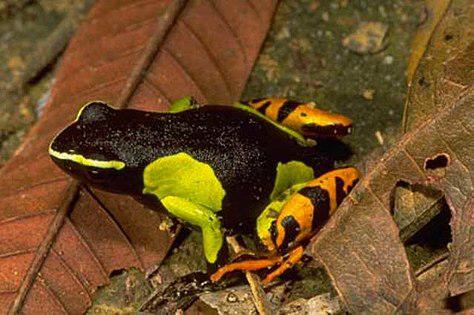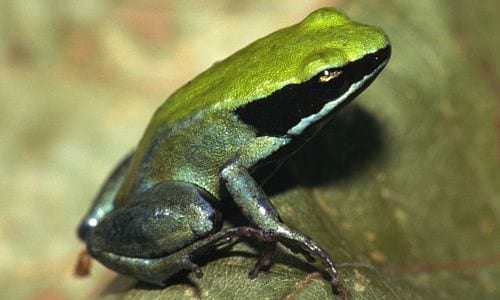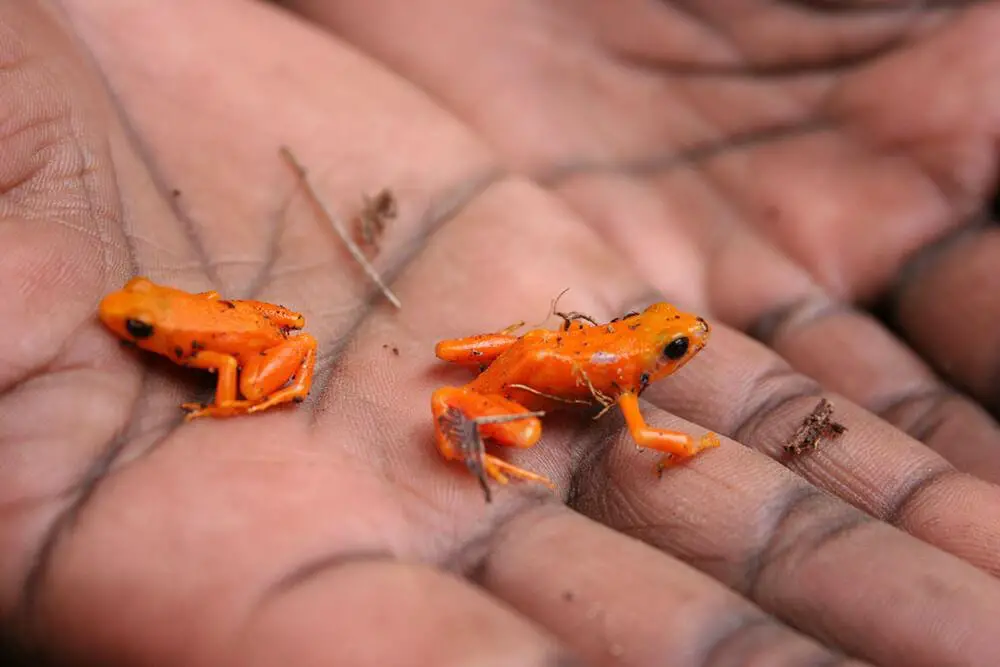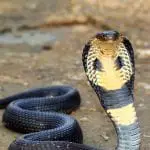Madagascar’s population has been reported to be increasing, and there is even a better need for more pasture and farming lands. Plus, as a consequence, forests have been disappearing, highland soils have been loosening, and catastrophic erosions have been unleashing. In some regions, reports show that annual soil loss has been reported to 112 tons per acre. This shocking amount is the largest recorded on earth.
As the forests have been retreating, the importance of the grown. These sites not only protect water resources for the country, it conserves soil, and it also serves as the home of very important and endemic species. This includes Madagascar’s golden mantellas.
The Basics on Madagascar’s Mantellas

Mantellas are very tiny frogs – even at full maturity, they can only reach more or less an inch long. They are also colored very brightly, and Madagascar Island serves as their natural home. They have been blessed with this striking coloration in order to warn potential predators of their toxicity, the same way that other frogs in nearby territories are designed. But, even though these frogs are known to be very similar to dart frogs, they are not relatives with each other. The fact that they are similar has been brought up by the concept of convergent evolution, which means where two unrelated animals evolve into similar adaptations with no correlation to one another.
It is also important to note that though these frogs have toxins running through their blood, Mantellas lose their poison and toxicity when they are bred in captivity. This happens mainly because of the changes in their diets. This is why Mantellas can also make great pets when you can care for them properly.
The Different Subspecies of Mantellas

There are 16 known subspecies of Mantella, and they are:
- Mantella laevigata group
- Mantella laevigata – Discovered by Methuen & Hewitt in 1913. Also known as the climbing mantella.
- Mantella manery – Discovered by Vences, Glaw & Böhme in 1999. Also known as the Marojejy mantella.
- Mantella betsileo group
- Mantella betsileo – Discovered by Grandidier in 1872. Also known as the Brown mantella.
- Mantella ebenaui – Discovered by Boettger in 1880. Also known as the Ebenau’s mantella.
- Mantella expectata – Discovered by Busse & Böhme in 1992. Also known as the Blue-legged mantella
- Mantella viridis – Discovered by Pintak & Böhme in 1988. Also known as the Green mantella.
- Mantella bernhardi group
- Mantella bernhardi – Discovered by Vences, Glaw, Peyrieras, Böhme & Busse, in 1994. Also known as Bernhard’s mantella.
- Mantella cowanii group
- Mantella cowanii – Discovered by Boulenger in 1882. Also known as the Cowan’s or Harlequin mantella.
- Mantella baroni – Discovered by Boulenger in 1888 . Also known as the Baron’s mantella.
- Mantella haraldmeieri – Discovered by Busse in 1981. Also known as the Harald Meier’s mantella.
- Mantella nigricans – Discovered by Guibé in 1978. Also known as the Guibe’s mantella.
- Mantella aurantiaca group
- Mantella aurantiaca – Discovered by Mocquard in 1900. Also known as the Golden mantella.
- Mantella crocea – Discovered by Pintak & Böhme in 1990. Also known as the Yellow mantella.
- Mantella madagascariensis – Discovered by Grandidier in 1872. Also known as the Malagasy mantella.
- Mantella milotympanum – Discovered by Staniszewski in 1996. Also known as the Black-eared mantella.
- Mantella pulchra – Discovred by Parker in 1925. Also known as the beautiful mantella.
The most common mantellas that are kept in captivity are:
- Golden mantella – This is the best-known subspecies of the mantellas, and they are the typical solid color mantellas – which can be orange, red, and yellow. It is partnered with solid black eyes that match their bold nature and diurnal habits. These species are critically endangered in the wild; it is still regularly bred and reproduced for pet trading.
- Baron’s mantella – Named after its original collector, Baron’s mantella is known for their black skin with some orange patches. They have emerald green front legs and shoulders with tiger-striped legs. It can be hard to breed these frogs consistently.
- Brown mantella – This is one of the least colorful species of the mantellas. It can be imported regularly, but it is not that common to breed them in captivity.
- Green mantella – This is one of the largest mantella species as the largest can measure about 1.25 inches in length, and it is endangered in the wild. They are green in over coloration and have a green stripe on their sides. If they have been captive-bred, they have colored yellowish-green. It can be difficult to breed them, but they lay huge clutches with about 100 eggs.
How To Acquire Mantellas

Captive-bred mantellas can be acquired from breeders, but finding one can be a little difficult to do. This is because compared to other frog species, mantellas can be a challenge to breed. Purchasing them can be a challenge because of their very small size and their delicate conditions during their early lives. But, of course, if you are really interested, you can definitely acquire them from a trusted captive breeder.
Most captive-bred mantellas are produced by dedicated frog hobbyists and enthusiasts and in online groups. You can start with the International Mantella Society group on Facebook, Josh’s Frogs in the US, and Understory Enterprises in Canada. These organizations have been working to perfectly breed mantellas in captivity, and many species can be acquired from them, depending on the season.
Just remember that captive-bred mantellas can be quite pricier if you compare them to those taken from the wild. But, even if the purchase price can be higher, it is a safer and easier raising and caring experience to get a captive-bred one.
Mantellas that are caught from the wild are found depending on the season, but you should consider the caring demands. Most of the time, mantellas from the wild come with parasites, and some even come with the presence of ranavirus and chytrid disease.
If you have found out that the mantella you have purchased came from the wild, take them to an experienced exotic veterinarian. You can check ARAV.org for a list of the active vets from the Association of Reptile and Amphibian Veterinarians. Have the mantella undergo laboratory tests and be prepared to administer them with their needed meds. If you have other pets, make sure that you quarantine the new one until they are fully checked out and have received the appropriate treatment.
When you select a frog, make sure that the one you are getting has at least lived 3 months out of the water, as younger ones are extra sensitive and can experience difficulties in traveling. Check out the frog for injuries and observe their activity.
A Few Caring Tips for Mantellas
- Mantellas thrive in a naturalistic vivarium that is surrounded by live plants. You can go with glass reptile terraria.
- Choose an enclosure that can provide cross ventilation.
- The enclosure can measure 10 gallons, about 12 inches tall at the minimum.
- In captivity, they enjoy eating fruit flies, pinheads, and crickets. You can also include some isopods, springtails, bean beetles, rice flower beetle larvae, and some black soldier fly larvae.
- Dust their meals with multivitamin and calcium supplements so that they stay healthy.
Conservation of Mantellas
A great way to support them is to donate funds to many conservation efforts in Madagascar. If you are also interested in keeping mantellas and protecting them against extinction, make sure that you only support captive breeding. Do not acquire them from the wild and consider breeding them, too, so that you can produce more individuals that many hobbyists can enjoy.
Madagascar’s Conserving Community
The local government of Madagascar has created community-based patrol units that are also partnered with Madagascar’s eight local villages. This has been established in recent years, and it has been proven that these patrol groups are helping to decrease illegal logging and illegal capture of the rare animals on the Island.
There are also numerous conservation orientation programs wherein locals were included in order to discuss the creation of wildlife and nature reserves. These meetings were held so that discussions can be made, and locals can raise questions and inquiries that they have.
Eventually, this resulted in the production of a co-management plan where the conservation association VIF (Vondrona Ivon’ny Fampandrosoana), The Rainforest Trust, the local government through the Madagascar Ministry of Forestry, and the locals all work collaboratively so that the reserve can be managed.
VIF also organized a series of hiragasys, which are a united singing of traditional songs and telling of stories that are all connected to biodiversity and environmental protection. They helped to invoke the spirit of their elders that are leaders of protecting the island’s unique and diverse wildlife.
The conservation organizations have also provided employment to the locals and residents on the island. This comprised of jobs related to researching and monitoring the amphibian populations, ecological tour guides, and helpers in reforesting the island’s natural resources.
So far, it has been reported that they were able to reforest 100 acres of land, there is a significant downfall on illegal logging, and frog communities are starting to rebound their populations.


